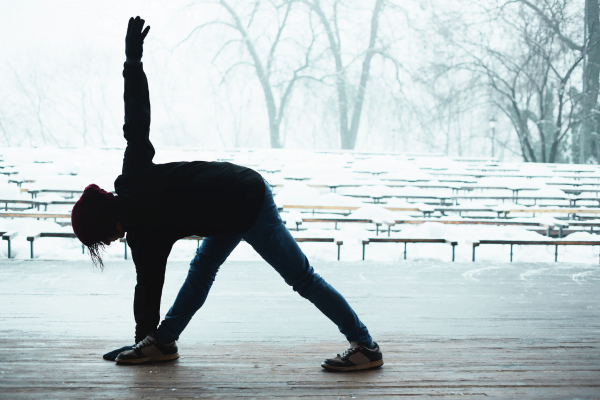Cold mornings can magnify stiffness and joint pain. Practical strategies for managing rheumatoid arthritis help you warm up safely, protect joints, and keep momentum through December’s colder days.
Key Takeaways
- Short, gentle warm-ups prepare joints and reduce morning stiffness risk.
- Layer heat, pacing, and medication timing to ease winter pain.
- Anti-inflammatory foods and hydration may support joint comfort.
- Know flare warning signs and pause exercise when needed.
Managing Rheumatoid Arthritis in Cold Weather
Lower temperatures and abrupt weather shifts can increase stiffness by tightening periarticular soft tissues and slowing circulation. That combination makes movement feel harder at the exact time your joints most need it. Building a routine with gradual warm-up, joint-friendly motion, and pacing often improves daily function during the colder months. It also helps you preserve strength without tipping into a flare.
Consider indoor alternatives when sidewalks are icy or winds are strong. A stationary bike, gentle yoga, or a warm-pool session can offer low-impact motion with less joint stress. For condition basics and common symptoms, see Rheumatoid Arthritis to anchor your plan. For broader activity guidance in arthritis, the CDC arthritis program shares safe movement principles that apply year-round.
Gentle Warm-Up Routine for December Days
Use a five- to ten-minute warm-up to boost tissue temperature and circulation before longer activity. Move slowly at first, and stop any motion that causes sharp or escalating pain. Pair breathing with motion, and aim for fluid ranges rather than maximal stretches. This routine is meant to complement your rheumatoid arthritis treatment rather than replace clinical care.
Begin seated or standing with posture awareness. Inhale through the nose for four counts and exhale for six to cue parasympathetic tone. Progress from smaller joints to larger ones: neck, shoulders, hands, hips, knees, and ankles. A short indoor walk afterward helps consolidate your gains and keeps joints supple as the day starts.
Hand and Wrist Sequence
Hands and wrists often feel tight in winter, especially upon waking. Start with ten gentle finger extensions and fists, followed by slow wrist circles in each direction. Next, open your fingers wide like a star, then bring thumb to each fingertip with light pressure. Finish with a towel squeeze for ten seconds, then relax for ten seconds; repeat three times. Keep each motion in a pain-free arc. If your hands feel warm and looser, you can add light resistance, such as a soft therapy putty, for several reps. If swelling or heat increases, pause and return to simple range-of-motion until symptoms settle.
Neck and shoulder sequence: Roll shoulders backward ten times, then forward ten, keeping neck long. Add small chin nods and side bends to reduce guarding. Hip and knee sequence: March in place for sixty seconds, then perform five sit-to-stand reps from a chair. Ankle sequence: Ten ankle pumps and circles per side. If morning joint signs concern you, see Early Signs of RA for context and monitoring tips.
Medication, Heat, and Pain Control
Layer strategies rather than relying on one tool. A warm shower or heating pad before activity can ease soft-tissue tightness. Many people apply a warm pack for ten minutes, then start their routine while tissues remain pliable. A topical NSAID may be useful for localized discomfort in certain joints, but individual tolerance varies. For medication class comparisons that support exercise comfort and safety, see RA Medication Types for a structured overview of options.
People often ask what is the best pain relief for rheumatoid arthritis, but there is no single answer. Some use acetaminophen, while others use an NSAID like celecoxib with prescriber guidance. For NSAID role, see Celebrex and Arthritis for balanced context on indications and cautions. If your care plan includes biologics or JAK inhibitors, you may wish to perform gentle exercise when you typically feel your best post-dose. For biologic injection details and format information, see Humira Prefilled Syringe, and for an oral JAK option overview, see Olumiant. For broader clinical principles, the American College of Rheumatology guidance summarizes standard approaches to medicines, safety, and monitoring.
Diet, Hydration, and Inflammation
Cold air is dry, and dehydration can worsen fatigue and cramping. Aim for steady fluids and warm, nutrient-dense meals. A practical rheumatoid arthritis diet emphasizes vegetables, legumes, fruits, whole grains, nuts, and omega-3–rich fish. Many people reduce ultra-processed foods, high sodium items, and excess added sugars during winter months because those patterns may aggravate swelling for some.
Antioxidant-rich berries and leafy greens support overall health, while olive oil and walnuts provide helpful fats. Ginger or turmeric can be used in cooking if tolerated. If you are reviewing medication-lifestyle tradeoffs, see Arthritis Pain Medication for a concise overview of non-drug supports that complement medical therapy. For evidence-informed nutrition context, the NIAMS overview describes standard care elements that lifestyle changes can support, while stressing the importance of individualized medical guidance.
Progression and Staging Basics
Understanding disease progression helps you match activity to your capacity. Clinically, what are the 4 stages of rheumatoid arthritis refers to a commonly used framing from early synovitis and minimal damage to more advanced joint changes over time. Early stages often involve intermittent swelling and morning stiffness, especially in small joints of the hands and feet. Later stages may bring persistent pain, erosions, and functional limits.
Function-focused exercise, splinting when indicated, and timely medication adjustments can help preserve motion in each stage. If you are noticing new symptoms in hands or wrists, review Early Signs of RA for practical red flags and next steps. Discuss any notable change with your rheumatology team to avoid deconditioning while protecting inflamed joints.
Diagnosis and Tests to Stay Ahead
Timely evaluation supports joint protection and better function. A formal rheumatoid arthritis diagnosis blends clinical exam with imaging and selected labs, such as rheumatoid factor or anti-CCP antibodies, alongside inflammatory markers. Ultrasound can help detect synovitis or erosions earlier than plain X‑rays in some cases. Your clinician will also consider duration of symptoms and joint distribution when weighing findings.
Classification criteria guide research and often inform clinical reasoning. For a lay-friendly summary of diagnostic concepts and standard testing, the American College of Rheumatology guidance discusses core features and evaluation components. Tracking your patterns—morning stiffness length, fatigue, and joint counts—helps make appointments more productive and allows tailored activity planning.
Family History and Risk Factors
Many people wonder, is rheumatoid arthritis hereditary, especially when multiple family members have joint issues. Genetics confer some risk, but environment, infections, hormones, and smoking history also contribute. That means family history matters, yet it does not determine your outcome. It is helpful context for screening and earlier attention to subtle symptoms during the winter months.
Keep a simple record of family autoimmune conditions alongside your own symptom timeline. Share it with your rheumatology team to sharpen risk discussions and to plan monitoring if needed. For accessible discussion of RA and background factors, the NIAMS overview provides balanced educational context and links to further resources.
Adjusting Plans With Your Rheumatology Team
Coordination matters when winter routines change. Discuss how exercise fits around your rheumatoid arthritis medication, especially if you notice predictable peaks and valleys in pain or energy. Some people prefer short activity blocks when stiffness is lowest; others benefit from pre-activity heat or a lighter day after a medication change.
Mechanism and safety details differ across drug classes. For a concise tour of options and how they are used together, see RA Medication Types to frame good questions for your next visit. If hydroxychloroquine is part of care, for mechanism details and appropriate use, see What Plaquenil Does, and for eye safety monitoring guidance, see Plaquenil Eye Exam.
Safety Checks and When to Pause Exercise
Differentiate routine winter stiffness from signs of a flare. New warmth, redness, marked swelling, or pain that increases with light activity suggests you should pause and reassess. Persistent pain at rest, rapid loss of joint motion, or systemic symptoms like fever deserves prompt medical attention. Cold-related discomfort usually eases with gradual movement and heat; a flare typically resists these measures.
Scale your routine on high-symptom days. Choose range-of-motion work and short bouts rather than pushing intensity. If other diagnoses overlap, such as osteoarthritis or tendon disorders, consider joint-specific modifications. For comparisons among arthritic conditions, see Osteoarthritis for context that may help disentangle symptoms and adjust plans safely.
Recap
Winter strategies work best when they are simple, repeatable, and responsive to your symptoms. Warm up gently, add heat when helpful, and fuel your day with supportive foods and steady hydration. Coordinate exercise with your care plan, monitor for flares, and keep communication open with your team.
Tip: Lay out layers, heat packs, and water the night before. Small cues reduce friction and make movement more likely on cold mornings.
Note: Track your wins. Even five minutes of motion counts and builds confidence for tomorrow.
This content is for informational purposes only and is not a substitute for professional medical advice.

